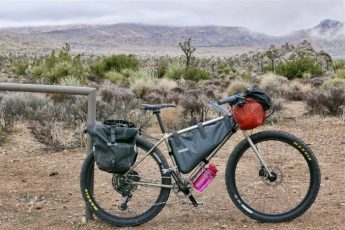Introduction
Quick Navigation
Are you thinking about changing from a regular rack and panniers setup to bike-packing bags? We brought about this transition while readying for a recent tour. After some comprehensive study and testing with both kinds of luggage, put together this bike-packing bags vs panniers pros and cons list to enable you to decide which to go with on your next tour. This guide assesses the volume and weight of the bags as well as variations in efficiency, procedure, ride quality, relief of use, expense, and supplementary.
Bikepacking Bags Vs Panniers and Racks: What’s the difference?
The advantage of bike-packing bags and panniers is to carry luggage on your bike. Normally speaking, bikepacking bags are formulated for off-road use while panniers and racks are formulated for road riding.
Racks and panniers are mainly wanted by bicycle tourists who wish to hold up all of the necessities for weeks, months or even years on the road. Lots of bicycle tourists expend more time riding on the pavement and travel far distances. Sometimes internationally.
Bikepacking bags are always chosen by those who expend more time riding off-pavement, on extended stretches of gravel roads, and single track through pastoral or wilderness areas. Most backpackers take a minimalist technique to pack to keep the bike lightweight and active.
What are Bikepacking Bags?
Bikepacking bags are soft bags that affix directly to the body of the bike with straps and Velcro. No metal racks are needed.
A wide spectrum of bike-packing bags has struck the market to fit several sizes and styles of bikes. You can discover bikepacking bags that will match pretty much every frame. Some factories are glad to manufacture custom bags for you as well.
A bike with bikepacking bags
A bikepacking bike with a handlebar roll, frame bag, and seat stack.
The main bike-packing bags include:
Handlebar harness or roll: This is practically a dry bag that restrains the handlebars with straps. A handlebar harness utilizes a different dry bag. This way, you can utilize various size bags banking on the quantity of gear you hold. A handlebar roll retains the dry bag built-in. With both modes, you access your gear from the aspects of the bag. Handlebar bags normally hold 15-20 litres of gear. Many prototypes offer attachment points on the outside where you can affix a small bag or additional gear. You can also affix your tent.
Frame bag: This unique shaped bag fits in the triangle of your bike shelf. Frame bags secure to the frame with Velcro or belts around the top tube, down tube, and seat tube. These always hold 8-14 litres of devices. They are always tailored made to maximize space because each bike shelf has a rarely different triangle geometry. These arrive in full frame and half frame sizes. The half-size style permits you to use your water bottle attachments levels in the triangle.
What Are Racks and Panniers?
Panniers are big rectangular bags that affix to metal racks on the front and rear of the bike. The racks bolt quickly to the frame. Panniers secure to the racks with a plastic or metal hook technique. The system differs by brand.
Front and rear racks and panniers on a touring bike
A normal rack and pannier setup include:
Rear Rack: The rack bolts instantly to the bike frame. Racks are formulated of steel, titanium, or aluminium.
Rear Panniers: These large backpacks attach to both sides of the rack. Collective, they fit 30-70 litres of equipment banking on style.
Front Rack: This rack affixes quickly to the fork. Some front racks are manufactured to only hold up panniers. Some offer a basket or flat spot where you can affix additional gear.
Front Panniers: These are portable than rear panniers. They fit 10-30 litres of appliances.
Handlebar bag: This cliff to the handlebars and hold up an additional 8-12 litres of gear. This is an incredible place to stock important items because the bag unfastens instantly and easily.
Bikepacking Bags benefits
The bike handles nicely with bike-packing bags
With bike packing bags, the weight of all of your gear is carried close to the bike’s centre of gravity. This allows you to maintain your load balanced. You won’t be too rear heavy or overloaded on one side. This enables you to corner predictably and precisely. You can heed a line better while driving on specialized terrain.
Bikepacking bags set less wear and tear on the bike and components.
Because you are holding up around less weight, you are setting less wear and tear on your bike. Rims, chains, cassettes, brake pads, tires, and chainrings last longer. This recoups you money on alternate parts and saves you time on expenditure.
Bikepacking bags give nicer aerodynamics
Bikepacking bags enable you to travel about 6.5% faster than panniers on a regular. The reason is the exceptional aerodynamics. Bikepacking bags keep everything simplified. No big heavy rectangular bags are bulging to each side resulting in drag and hindering you down.
Bikepacking bags can be mounted to any bike
Some bikes don’t possess the mandatory braze-on for mounting racks. This is very common on bikes with carbon fibre frames, full-suspension mountain bikes, and folding bikes. Any bike can be fitted with bike-packing bags because they attach with Velcro and belts. Nothing latches to the frame. This enables you to tour on any bike.
If your bikepacking bags tear, you can fix them yourself
Because backpacking bags are formulated of fabric, you can effortlessly repair holes with a needle and thread. A small sewing kit is lightweight and resorts to very little space. You can also use the same sewing kit that you utilize for tubeless tire repair. If you are touring to an isolated place and your metal rack breaks, you could be out of luck.
Conclusion
If you’re touring long term or during the winter when you’ll require bulky gear, panniers are the best option. There is a lot of room for additional warm clothing, food, amenity items, electronics, and antiques.

